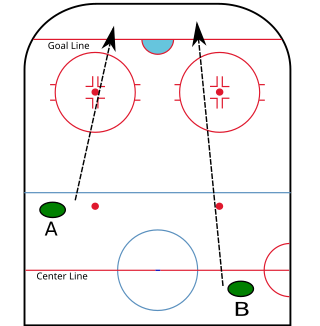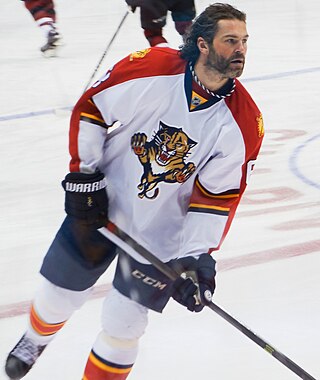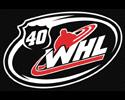
Ice hockey is a team sport played on ice skates, usually on an ice skating rink with lines and markings specific to the sport. It belongs to a family of sports called hockey. In ice hockey, two opposing teams use ice hockey sticks to control, advance, and shoot a closed, vulcanized, rubber disc called a "puck" into the other team's goal. Each goal is worth one point. The team which scores the most goals is declared the winner. In a formal game, each team has six skaters on the ice at a time, barring any penalties, one of whom is the goaltender. Ice hockey is a full contact sport, and is considered to be one of the more physically demanding team sports. It is distinct from field hockey, in which players move a ball around a non-frozen pitch using field hockey sticks.

In many team sports, defense or defence is the action of preventing an opponent from scoring. The term may also refer to the tactics involved in defense, or a sub-team whose primary responsibility is defense. Similarly, a defense player or defender is a player who is generally charged with preventing the other team's forwards from being able to bear down directly on their own team's goalkeeper or goaltender. Such positions exist in association football, ice hockey, water polo and many other sports.

In ice hockey, a goal is scored when the puck entirely crosses the goal line between the two goal posts and below the goal crossbar. A goal awards one point to the team attacking the goal scored upon, regardless of which team the player who actually deflected the puck into the goal belongs to. Typically, a player on the team attempting to score shoots the puck with their stick towards the goal net opening, and a player on the opposing team called a goaltender tries to block the shot to prevent a goal from being scored against their team.

In ice hockey, icing is an infraction when a player touches the puck over the center red line and then opposing team's red goal line, and the puck remains untouched without scoring a goal.

The centre in ice hockey is a forward position of a player whose primary zone of play is the middle of the ice, away from the sideboards. Centres have more flexibility in their positioning and therefore often end up covering more ice surface than any other player. Centres are ideally strong, fast skaters who are able to backcheck quickly from deep in the opposing zone. Generally, centres are expected to be gifted passers more so than goal scorers, although there are exceptions - typically larger centres who position themselves directly in front of the net in order to score off rebounds. They are also expected to have exceptional "ice vision", Hockey IQ, intelligence, and creativity. They also generally are the most defensively-oriented forwards on the ice, as they are expected to play the role of the third player in defense, after the defencemen. Centres usually play as part of a line of players that are substituted frequently to keep fresh and keep the game moving.
In ice hockey, a forward is a player, and a position on the ice, whose primary responsibility is to score and assist goals.

Winger, in the game of ice hockey, is a forward position of a player whose primary zone of play is along the outer playing areas. They typically flank the centre forward. Originally the name was given to forward players who went up and down the sides of the rink. Wingers generally have the least defensive responsibilities out of any position on the ice, however they are still tasked with defensive duties such as forechecking duties or covering the point in the defensive zone.

Defence or defense in ice hockey is a player position that is primarily responsible for preventing the opposing team from scoring. They are often referred to as defencemen, D, D-men or blueliners. They were once called cover-point.

An ice hockey rink is an ice rink that is specifically designed for ice hockey, a competitive team sport. Alternatively it is used for other sports such as broomball, ringette, rinkball, and rink bandy. It is a rectangle with rounded corners and surrounded by walls approximately 1.22 metres (48 in) high called the boards.
Checking in ice hockey is any of a number of defensive techniques aimed at disrupting an opponent with possession of the puck or separating him from the puck entirely. Most types are not subject to penalty.

A slapshot is a powerful shot in ice hockey. Its advantage is as a high-speed shot that can be taken from a long distance; the disadvantage is the long time to set it up as well as its low accuracy.

A shot in ice hockey is an attempt by a player to score a goal by striking or snapping the puck with their stick in the direction of the net.

The neutral zone trap is a defensive strategy used in ice hockey to prevent an opposing team from proceeding through the neutral zone and to force turnovers.

In ice hockey, a deke is a type of feint or fake technique whereby a player draws an opposing player out of position or skates by the opponent while maintaining possession and control of the puck. The term is a Canadianism formed by abbreviating the word decoy.
In ice hockey, a play is offside if a player on the attacking team does not control the puck and is in the offensive zone when a different attacking player causes the puck to enter the offensive zone, until either the puck or all attacking players leave the offensive zone. Simply put, the puck must not enter the attacking zone after attacking players. If a player on the attacking team is in the offensive zone before the puck, either an immediate offside occurs, or they must retreat to the neutral zone.

Roller in-line hockey, American roller hockey or inline hockey, is a variant of hockey played on a hard, smooth surface, with players using inline skates to move and ice hockey sticks to shoot a hard, plastic puck into their opponent's goal to score points. The sport is a very fast-paced and free-flowing game and is considered a contact sport, but body checking is prohibited. There are five players including the goalkeeper from each team on the rink at a time, while teams normally consist of 16 players. There are professional leagues, one of which is the National Roller Hockey League (NRHL). While it is not a contact sport, there are exceptions, i.e. the NRHL involves fighting.

The 2005–06 WHL season was the 40th season for the Western Hockey League. Twenty teams completed a 72-game schedule. The Vancouver Giants won the President's Cup.

The National Hockey League rules are the rules governing the play of the National Hockey League (NHL), a professional ice hockey organization. Infractions of the rules, such as offside and icing, lead to a stoppage of play and subsequent face-offs, while more serious infractions lead to penalties being assessed to the offending team. The league also determines the specifications for playing equipment used in its games.
This is a list of common terms used in the sport of ice hockey along with the definitions of these terms.
The forecheck is an ice hockey defensive coverage play made (primarily) in the offensive zone with the objective of applying pressure to the opposing team to regain control of the puck. It is a type of checking. Forechecking is generally executed in one of three situations: recovery of the puck after a dump in, after the rebound following a scoring attempt, or immediately after a turnover to regain possession. Forechecking can be aggressive or conservative depending on the coaching style and on the skating skills of the players.












